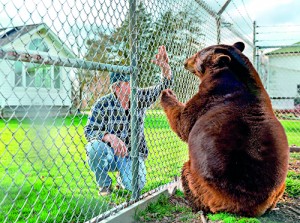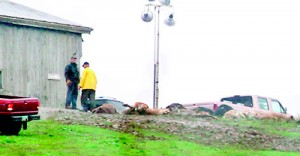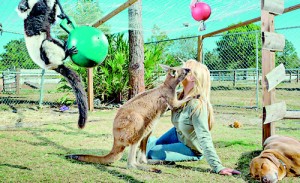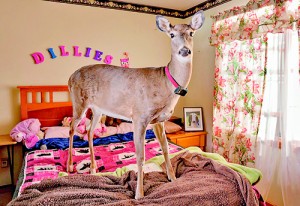Sunday Times 2
Wild obsession
All across the nation, in Americans’ backyards and garages and living rooms, in their beds and basements and bathrooms, wild animals kept as pets live side by side with their human owners. It’s believed that more exotic animals live in American homes than are cared for in American zoos. The exotic-pet business is a lucrative industry, one that’s drawn criticism from animal welfare advocates and wildlife conservationists alike. These people say it’s not only dangerous to bring captive-bred wildlife into the suburbs, but it’s cruel and it ought to be criminal too. Yet the issue is far from black or white.
At least not to Leslie-Ann Rush, a horse trainer who lives on a seven-acre farm outside Orlando, Florida, a place where the wind makes a rustling sound when it whips through the palms. Rush, 57, who has a kind face and hair the colour of corn, breeds and trains gypsy horses she houses in a barn behind her small petting zoo, a wire enclosure where three male kangaroos, four lemurs, a muntjac deer (originally from Asia), a potbellied pig, a raccoon-like kinkajou called Kiwi, and a dog named Dozer all live-the lemurs leaping freely, the kangaroos sleeping on their sides, the petite pig rooting in the ground, the Asian deer balancing its rack of antlers on its delicate head.
Rush weaves in and around her exotic pets with ease and cheerfulness and Cheerios, doling them out to the lemurs. They thrust their humanlike hands into the open boxes and draw out fistfuls of O’s, which they eat almost politely, one by one, dining daintily while the drool gathers in the corners of their mouths.

John Matus bought Boo Boo impulsively as a cub. Last summer the Ohio man gave her to a wildlife sanctuary. "She needs to be with her own kind," he says. "It's a lonely life." (Photograph by Vincent J. Musi)
Rush has a ring-tailed lemur, Liam; two ruffed lemurs, Lolli and Poppi; and a common brown lemur named Charlie. While many lemurs are threatened, the ruffed lemurs are considered critically endangered in the wild. Rush believes that by caring for these captive-bred creatures she is doing her part to help keep lemurs alive on Earth, and she cares for her animals with a profound commitment that consumes her days and even her nights. As darkness falls, she moves from the small enclosure into her home and takes her favourite lemur with her; he shares her bed, coiled up on a pillow by her head.
Because kangaroos are active typically at dawn and dusk, the animals look lazy in the daylight, dun-coloured beasts lying on their sides in cylinders of sun, their thick tails trailing in the dry dirt. But come evening they hop up on their hind legs and press their faces against the large glass window, looking in on Rush in her home: Let me come in, they seem to say. Rush does not let them in, although she did when they were babies. “I have all of these amazing animals of different species, from different continents, and the thing is, they play together,” she says, and she sweeps her hand through the air, gesturing to her multicoloured menagerie sunning, sleeping, snacking.
Despite occasional reports of wild kangaroos attacking humans in Australia, Rush’s pets display not a hint of aggression. This may have something to do with the fact that kangaroos are naturally somnolent during daytime hours, and it may also have something to do with the fact that Rush’s kangaroos are no longer truly wild: They were bred in captivity; two of them have been neutered; they are used to human contact. Rush raised each kangaroo in nappies, bottle-fed it, and, touching the sleek suede fur continually, accustomed each animal to human hands.
The $35 that Rush charges to visit what she calls her Exotic Animal Experience helps defray the costs involved in keeping her pets. Some exotic-animal owners spend thousands a year on fresh meat, for carnivores that dine daily on raw steak, for primates-omnivores with complex dietary needs-for snakes, which eat rat after rat after rat. In Rush’s case her kangaroos consume huge quantities of grain, while the lemurs eat mounds of fruits and vegetables.
Rush herself lives a lean life, much of her own money poured into feeding her herd. And then there’s her time. She puts abundant hours into caring for her exotics. “They’re 24/7,” she says, and then goes on to add, “but they’re my family. They need me. I can’t explain to you what that feels like. I wake up every morning and come out here, and all my animals come rushing up to greet me. I feel loved, and that feels great.
“My family,” she repeats, and a shadow sweeps across her face. “All my life,” she says, “people have let me down. My animals never have.”
Privately owning exotic animals is currently permitted in a handful of states with essentially no restrictions: You must have a license to own a dog, but you are free to purchase a lion or baboon and keep it as a pet. Even in the states where exotic-pet ownership is

Dead animals, including lions and tigers, lie near Terry Thompson's Ohio game reserve after being shot by police (Reuters)
banned, “people break the law,” says Adam Roberts of Born Free USA, who keeps a running database of deaths and injuries attributed to exotic-pet ownership: In Texas a four-year-old mauled by a mountain lion his aunt kept as a pet, in Connecticut a 55-year-old woman’s face permanently disfigured by her friend’s lifelong pet chimpanzee, in Ohio an 80-year-old man attacked by a 200-pound kangaroo, in Nebraska a 34-year-old man strangled to death by his pet snake. And that list does not capture the number of people who become sick from coming into contact with zoonotic diseases.
The term exotic pet has no firm definition; it can refer to any wildlife kept in human households-or simply to a pet that’s more unusual than the standard dog or cat. Lack of oversight and regulation makes it difficult to pin down just how many exotics are out there. “The short answer is, too many,” says Patty Finch of the Global Federation of Animal Sanctuaries. It’s estimated that the number of captive tigers alone is at least 5,000-most kept not by accredited zoos but by private owners. And while many owners tend to their exotic pets with great care and at no small expense, some keep their pets in cramped cages and poor conditions.
Commercially importing endangered species into the United States has been restricted since the early 1970s. Many of the large exotic animals that end up in backyard menageries-lions and tigers, monkeys and bears-are bred in captivity. Today on the Internet you can find zebras and camels and cougars and capuchins for sale, their adorable faces staring out from your screen; the monkeys with their intelligent eyes; the big cats with their tawny coats. And though such animals are no longer completely wild, neither are they domesticated-they exist in a netherworld that prompts intriguing questions and dilemmas.

"My life is completely about the animals," says Leslie-Ann Rush, a Florida horse trainer. "I rarely leave them overnight or take a vacation." She raised her kangaroos and lemurs from infancy (Photograph by Vincent J. Musi)
“I wanted something different, something unusual,” says Michelle Berk, formerly of Palisades, Florida, who bought her kinkajou, Winnie, on craigslist. “She was there for me to make my own. We didn’t get a dog because there’s nothing cool or outstanding about owning a dog. A kinkajou-now that seems untouchable. And who doesn’t want the untouchable? They say don’t touch it, so you want to touch it.”
Tim Harrison understands the allure of owning exotic pets. Thirty-two years ago he worked as a public safety officer in the city of Oakwood, Ohio, and kept a menagerie in his house. He had snakes wrapped around lamp poles. He had rhesus monkeys leaping from counter to couch. He had lions sunning themselves on his gravel driveway. He had capuchins and bears and wolves, which were his favourites.
Now the animals are gone. Harrison will never again own anything wild or exotic. He believes ownership of all potentially dangerous exotic animals should be banned and is working to make that happen. He underwent a profound transformation, his entire outlook shattered and put back together again in a new way.
What happened is this: After decades of being an exotic-pet owner, Harrison went to Africa. He drove over the open plains and grasslands, and he can remember, all these years later, the giraffes’ long lope, the lions’ hypnotic canter, the elephants sucking water up their trunks and spraying themselves so their hides glistened. Harrison gazed upon these wild animals, and he says it was as if his

Ohio veterinarian Melanie Butera took in Dillie after the blind farm deer's mother rejected her. Dillie used to sleep with Butera but now has her own room. "She's treated like a princess," says Butera (Photograph by Vincent J. Musi)
eyes had been blistered shut and were suddenly opened as he witnessed these mammals moving in such profound harmony with their environment that you could hear it: a rhythm, a pulse, a roar. This, Harrison suddenly realised, was how wild animals are supposed to live. They are not supposed to live in Dayton or any other suburb or city; they are creatures in and of the land, and to give them anything less suddenly seemed wrong.
When he returned to Ohio, one by one he gave up his beloved wolves and primates and cats and handed them over to sanctuaries where they’d at least have safety and space. It hurt him to do this. He knew his wolves so well he could howl a hello, and a goodbye.
Today Harrison is retired from the police force. He puts as many hours as he can into Outreach for Animals, an organisation he helped found to rescue exotic pets and place them in one of the sanctuaries he trusts.
Harrison feels empathy for wild animal owners, whose affection he so well understands. He loved his animals. He believed, as most owners do, that his animals loved him. He believed that having a thriving menagerie made him special. “But I was deluded,” he says. “I used to believe there was no animal I could not tame, no animal I was unable to train, and that any animal living under my roof was receiving the best of care.” The delusion, rooted in a deep desire to commune with wild animals, has lingered long after the beasts were gone. Every time he participates in a rescue he has to stop himself from taking the animal home. “I try to keep my contact with the animals I rescue to a minimum,” Harrison explains, “because my addiction can come back at a moment’s notice.”
The state of Ohio has become ground zero for the debate over exotic-animal ownership, and here’s why: In October 2011, outside the city of Zanesville, in Muskingum County, a man named Terry Thompson let 50 of his wild animals, including lions and tigers, out of their cages and enclosures before killing himself. The local sheriff’s department had little choice but to shoot most of the animals, which were dodging cars, loping across backyards, and posing a threat to public safety. Prior to the Zanesville incident, Ohio was one of a handful of states that required no license or permit to keep an exotic or wild animal as a pet.
The Zanesville tragedy woke Ohio up. In response to the outcry over the sight of exotic carcasses lined up near Thompson’s property, the governor of Ohio signed an executive order cracking down on unlicensed animal auctions. The state now requires owners of “dangerous exotic animals” to have a permit, to microchip their pets, to establish a relationship with a veterinarian, and to buy insurance.
Sheriff Matthew Lutz was the one who gave the order to shoot the animals after Thompson released them from their cages. The incident continues to haunt him. He has joined forces with animal rights activists who have lobbied for years, to no effect so far, for a federal law that would prohibit the private possession and breeding of large cats except by zoos and other registered facilities.
Like Rush, many exotic-pet owners and private breeders say they are motivated by a desire to preserve and protect threatened species. “Climate change and human population growth could wipe out a species in record time, so having a backup population is a good idea,” says Lynn Culver, a private breeder of felines and executive director of the Feline Conservation Federation who believes that “those who do it right should have the right to do it.”
If a federal law ever passes, violators could face a fine and time in gaol, as well as have their animal confiscated. That prospect enrages some exotic-animal owners, who argue that the number of incidents involving injuries from exotic pets pales in comparison to the number of people who visit the emergency room for dog bites each year.
“Placing bans on wild animal ownership will only increase the population of illegal exotics out there,” says Zuzana Kukol, who co-founded REXANO (Responsible Exotic Animal Ownership) to oppose bans on the private ownership or use of animals. “Bans do not work. We’ve seen this with alcohol and prostitution.”
It’s true that even in states where wild animal ownership is explicitly banned, existing laws are not well enforced. The market for exotics is so alive and thriving that to call it underground is a bit misleading.
At the raucous auctions held in muddy fields or paved parking lots, auctioneers hold out adorable tiger cubs with scrumptious soft scruffs or display tiny chimps in baseball hats and T-shirts that say, “I (heart) you.” But people don’t realise that all too soon that adorable tiger will outgrow its role as family pet and end up confined in a chain link enclosure.
The breeders stand to make hundreds of thousands of dollars during an auction. They coach their auctioneers-the middlemen-to tell prospective buyers that their animals, usually babies, are harmless, and they are correct. “The problem comes,” says Harrison, “when the animal reaches sexual maturity and its natural predator instinct kicks in.”
Remember Michelle Berk and her kinkajou? Like so many other wild animal stories, Winnie’s came to a sad end. For years Berk kept the kinkajou in peace, but when the animal went into her first heat, her behaviour changed. She tried to eat her own tail as Berk and her family tried to protect themselves while stopping the kinkajou from tearing herself to pieces. After that Berk turned Winnie over to a sanctuary. “It’s like we lost a child. She’ll always be our baby. Now she has gone to a place where she’ll finally get to be a kinkajou,” says Berk, who seems at peace with the decision. “I’ve learned that Winnie never really needed us. She didn’t need to be our pet. She didn’t need to be locked up. We got her because we needed her.”
Adam Roberts of Born Free USA says his organisation’s mission is to keep wildlife in the wild, where it belongs. When humans choose to keep what are supposed to be wild animals as pets, we turn them into something outside of wild, something for which nature has no place. In the famous children’s book Where the Wild Things Are, a boy sails on a boat to an island where he dances with beasts born from his own imagination. In the end what we learn from exotic-pet ownership is that when you take the wild out of the wild, you eradicate its true nature and replace it with fantasy-the fantasy being ours, we humans, the animals at once the most and the least tamed of all.
(Courtesy National Geographic)
| President’s Macaw back in cage
When President Mahinda Rajapaksa returned to the President’s House in the Fort after his Avurudu holiday in Hambantota he was shocked to find that his four Macaw pets had escaped from their cage. A big hunt was launched. Three of the birds were recaptured at Kompanna Veediya and Modera and the fourth at Kotahena. |

